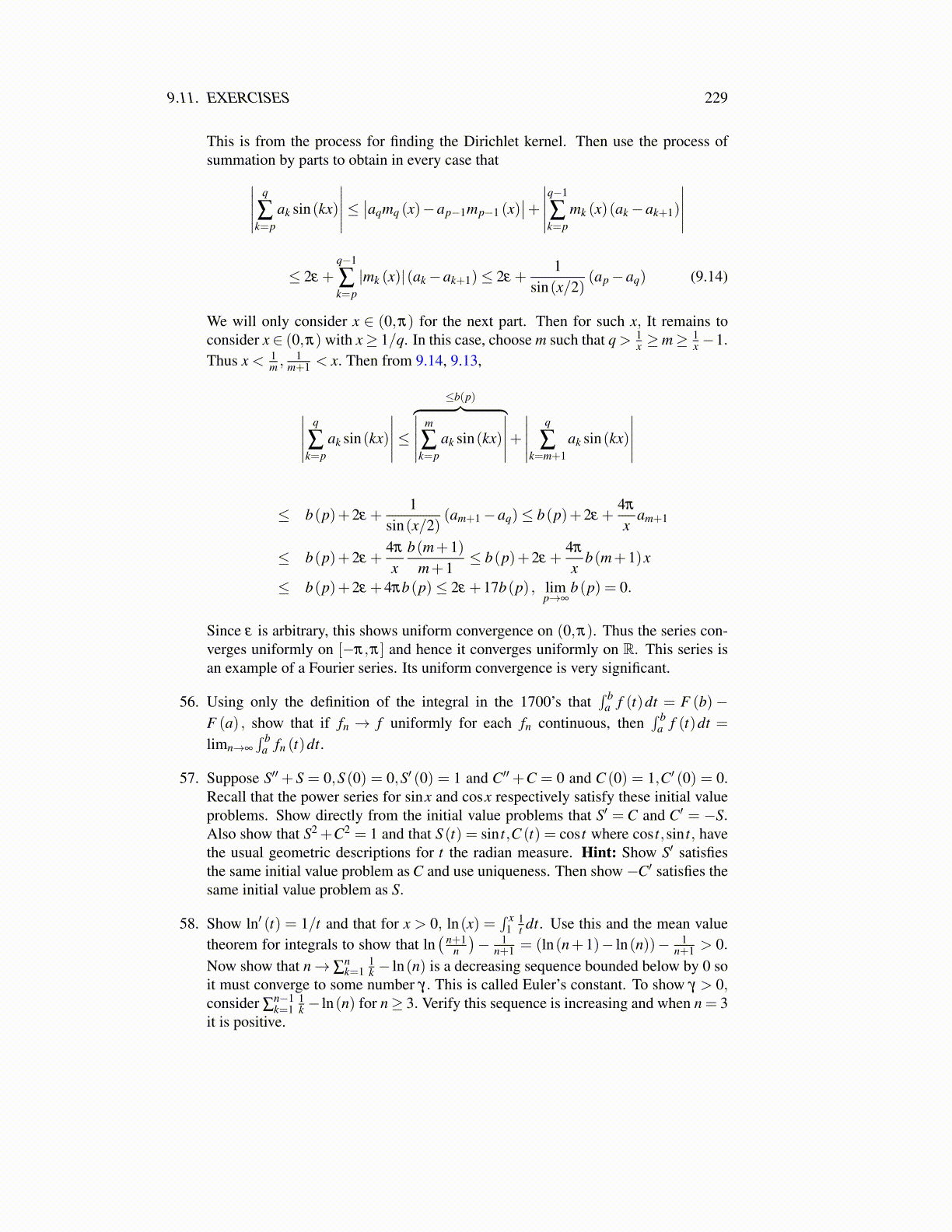
Chapter 10
Improper IntegralsIn everything, it is assumed that f is Riemann integrable on finite intervals, usually piece-wise continuous on finite intervals. Thus there is no issue about whether the Riemann inte-gral of the function on a finite interval exists. In this chapter, the integrator function will beg(x) = x. Also I will write an ↓ a to mean that {an} is decreasing and limn→∞ an = a. Thesymbol bn ↑ b is defined similarly but here bn is increasing and has limit b.
To begin with, assume the functions are real valued.
Definition 10.0.1 Let a≥−∞ and b≤ ∞. A function f is improper Riemann inte-grable if it is Riemann integrable on all intervals [α,β ]⊆ (a,b) and if there is a number Isuch that whenever an ↓ a, and bn ↑ b, it follows that limn→∞
∫ bnan
f (t)dt = I. Then I will bedenoted as
∫ ba f (t)dt. A function f is in L1 (a,b) if | f | is improper Riemann integrable.
Proposition 10.0.2 Let a,b be as in Definition 10.0.1 and let f be a function Riemannintegrable on each [α,β ]⊆ (a,b). Then f ∈ L1 (a,b) if and only if
sup{∫
β
α
| f (t)|dt : [α,β ]⊆ (a,b)}≡ I < ∞
and in this case,∫ b
a | f (t)|dt = I. Also, whenever f is in L1 (a,b) , it is improper Riemannintegrable.
Proof: ⇒ Say f ∈ L1 (a,b) . If I = ∞, then there would exist αn ↓ a,β n ↑ b andlimn→∞
∫β nαn| f (t)|dt = ∞ contrary to assumption.
⇐ Say I < ∞. Then pick α,β , with [α,β ] ⊆ (a,b) and I − ε <∫
β
α| f (t)|dt < I. If
an ↓ a,bn ↑ b, then for all n large enough, α > an > a and β < bn < b and so also, for all nlarge enough, I− ε <
∫β
α| f (t)|dt <
∫ bnan| f (t)|dt < I. Thus limn→∞
∫ bnan| f (t)|dt = I.
Consider f ∈ L1 (a,b). Letting an ↓ a,bn ↑ b,∫ bn
an
f (t)dt =∫ bn
an
| f (t)|+ f (t)2
dt−∫ bn
an
| f (t)|− f (t)2
dt
Now both of those two integrals on the right are increasing in n because the integrands arenonnegative and they are also bounded above by
∫ ba | f (t)|dt and so they both converge.
Therefore, limn→∞
∫ bnan
f (t)dt also exists.The claims of the following example are easy and are left for you to verify.
Example 10.0.3 If f (x) = x−p, for p ∈ (0,1) , then f ∈ L1 (0,1) . If f (x) = e−x, then f ∈L1 (−a,∞) for any a < ∞. If f (x) = 1/x2, then f ∈ L1 (1,∞). If f (x) = e−tt−p where p > 0,then f ∈ L1 (0,∞).
Note that it follows from the above Definition 10.0.1 that if f ∈ L1 (−∞,∞) , then if(a,b) ⊆ (−∞,∞) , then f X(a,b) ∈ L1 ((a,b)). Here X(a,b) (x) is 1 if x ∈ (a,b) and 0 ifx /∈ (a,b). Also clear is that if f ,g∈ L1 (a,b) , then for any scalars α,β ,α f +βg∈ L1 (a,b)also. Using Problem 64 on Page 228 it is routine to show that if f ∈ L1 (−∞,∞), then ifg(u) = f (x−u) or f (x+u) it follows that g ∈ L1 (−∞,∞) also. Also note that if a is finiteand f is bounded near a by M then
∣∣∣∫ bna f (t)dt−
∫ bnan
f (t)dt∣∣∣ ≤ M |an−a| so there is no
harm in simply considering∫ bn
a f (t)dt in the definition.
229